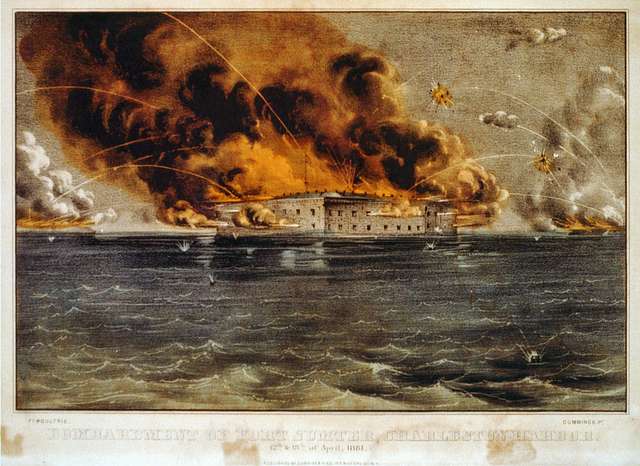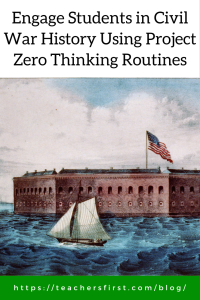
- What do you SEE in this image? (Just the observable details)
- What do you THINK might be happening? (Interpretations)
- What does this make you WONDER about teaching the Civil War? (Questions raised but unanswered)
These questions form the powerful See, Think, Wonder thinking routine developed by researchers at Harvard Graduate School of Education’s Project Zero. This routine and many others available through Project Zero’s Thinking Routine Toolbox (reviewed here) offer excellent frameworks to enhance student understanding of the complex economic, social, political, and moral considerations of the American Civil War which began with the bombardment of Fort Sumter in Charleston, South Carolina on April 12, 1861.
Why Thinking Routines Matter
Thinking routines serve multiple purposes in the classroom. They allow teachers to make student thinking visible, providing insight into understanding and thinking processes. These structured tools scaffold learning while reinforcing critical thinking skills by helping students explore issues from different perspectives. Most importantly, they create classroom cultures where thinking is valued, visible, and actively promoted.
As you explore the Thinking Routine Toolbox, take advantage of different ways to find and implement routines. Begin with Core Thinking Routines that work across grade levels to introduce the concept, then expand to other routines that align with specific learning objectives.
Building Understanding Across Grade Levels
Early Elementary (K-2):
Young learners begin their historical journey through accessible routines that spark curiosity and build basic frameworks. Start with See, Think, Wonder using simple visuals like illustrations of Fort Sumter or soldiers in uniform. One second-grade teacher reported that when her students examined a photograph of Fort Sumter, they noticed the American flag flying and wondered why Americans would fight each other—opening a perfect opportunity to introduce the concept of a divided nation.
As students gather basic Civil War facts, the I Used to Think… Now I Think routine captures their evolving understanding. Primary students often move from simplistic understandings (“I used to think the Civil War was about being mean”) to more nuanced concepts (“Now I think people were fighting because they couldn’t agree about important rules”).
To develop early empathy skills, Step Inside encourages perspective-taking through age-appropriate characters. Children might imagine being a Union soldier far from home or a Southern child hearing war news for the first time. These experiences naturally lead to understanding basic narrative structure through Beginning-Middle-End, helping young students grasp that historical events unfold in sequences with causes and effects.
Upper Elementary (3-5):
As students develop more sophisticated thinking skills, they’re ready to examine different viewpoints on the conflict. The Circle of Viewpoints routine helps children examine multiple perspectives—Northern citizens, Southern citizens, political leaders—and understand how the war impacted different groups.
The Color-Symbol-Image routine engages students’ creative thinking through three forms of expression. One fifth-grade class created powerful symbols representing the attack on Fort Sumter, with several students choosing broken chains to represent the conflict’s connection to slavery.
Rather than simply memorizing chronology, the Headlines routine challenges students to create newspaper headlines for events leading to Fort Sumter. This identification of key moments helps students develop skills in determining historical significance—what matters and why.
Middle School (6-8):
Middle school students are ready for deeper analysis of historical texts. The Claim-Support-Question routine offers an excellent framework for examining simplified versions of Lincoln’s speeches or newspaper accounts of Fort Sumter. Students identify claims made in the text, find supporting evidence, and generate questions about remaining uncertainties.
The visual metaphor in Tug of War helps students map competing forces pulling the nation toward conflict or compromise. Students identify factors on each side of the “rope,” creating a visual representation of the tensions that led to war.
When introducing new information, Connect-Extend-Challenge helps students build upon prior knowledge. They identify connections to what they already know, how the new information extends their thinking, and what challenges or puzzles remain.
For close reading of primary sources, Word-Phrase-Sentence provides structure that helps students focus on a text’s essence. Students select a significant word, phrase, and sentence from documents like Lincoln’s Gettysburg Address, creating an entry point for deeper discussion
High School (9-12):
High school students are capable of sophisticated historical analysis, and thinking routines can scaffold this complex thinking. The deceptively simple What Makes You Say That? routine encourages students to support interpretations with evidence—a core historical thinking skill.
For examining controversial topics from multiple perspectives, Compass Points (E-W-N-S) uses a compass metaphor. When studying Lincoln’s Emancipation Proclamation, students might explore Excitements, Worries, Needs, and Stance/Steps from various historical perspectives.
The 4 C’s framework (Connections, Challenges, Concepts, Changes) guides students through deep analysis of complex historical texts like the Cornerstone Speech, Lincoln’s First Inaugural Address, or Frederick Douglass’s speeches.
To consider how attitudes and ideas change over time, Projecting Across Time encourages historical perspective-taking. Students might examine evolving views on secession, the war’s impact on divided families, or changing perceptions of the Underground Railroad.
Resources for Implementation
Learning to effectively implement thinking routines takes practice. These resources offer guidance:
- OK2Ask: Engage & Inspire with Thinking Routines
- TeachersFirst Blog: Thinking Routines: A Universal Tool for Deeper Thinking
- Podcast: Thinking Routines: What’s the Big Idea?
Civil War Resources to Pair with Thinking Routines
Enhance your thinking routines with these quality Civil War resources:
- National Park Service Fort Sumter and Fort Moultrie: videos, photos, maps
- CuriConnect Book List: Civil War: reading suggestions for all ages
- Reading Treks: Henry’s Freedom Box
- Special Topics Collection: American Civil War Resources
Creating Thinking Classrooms
Incorporating thinking routines into Civil War instruction creates classroom environments where students actively construct understanding rather than passively receiving information. These routines encourage exploration from multiple perspectives while developing critical thinking structures that apply beyond history to real-world contexts.
What thinking routines have you found most effective in teaching about the Civil War? Share your experiences and ideas with our community as we learn together.


